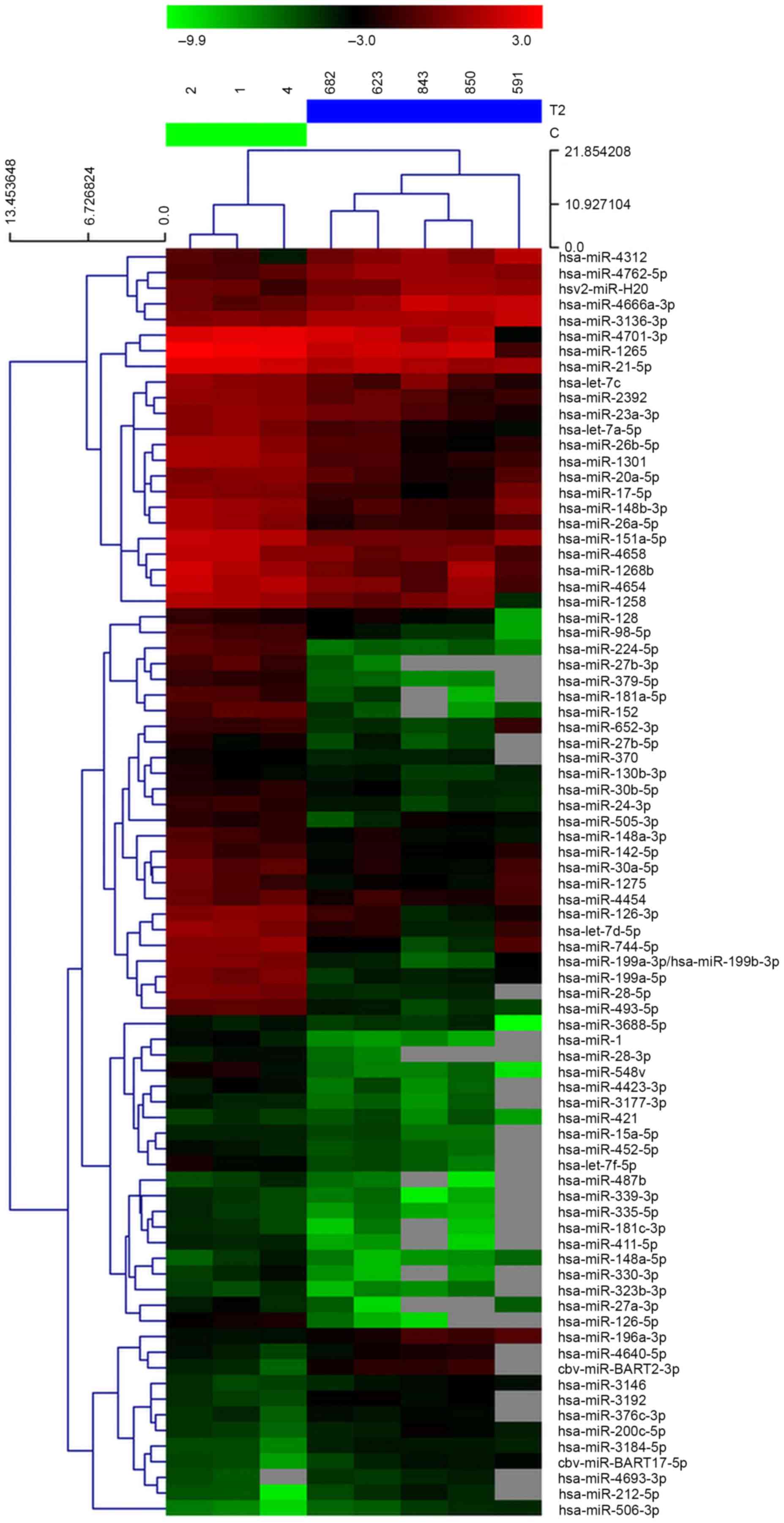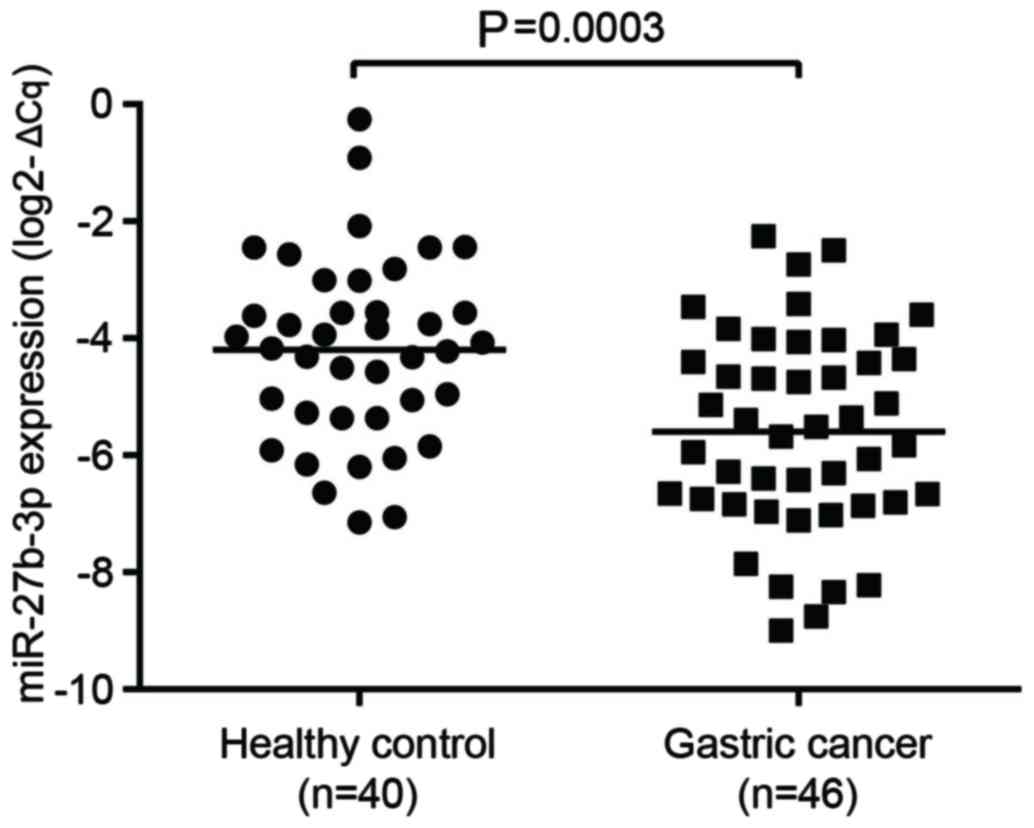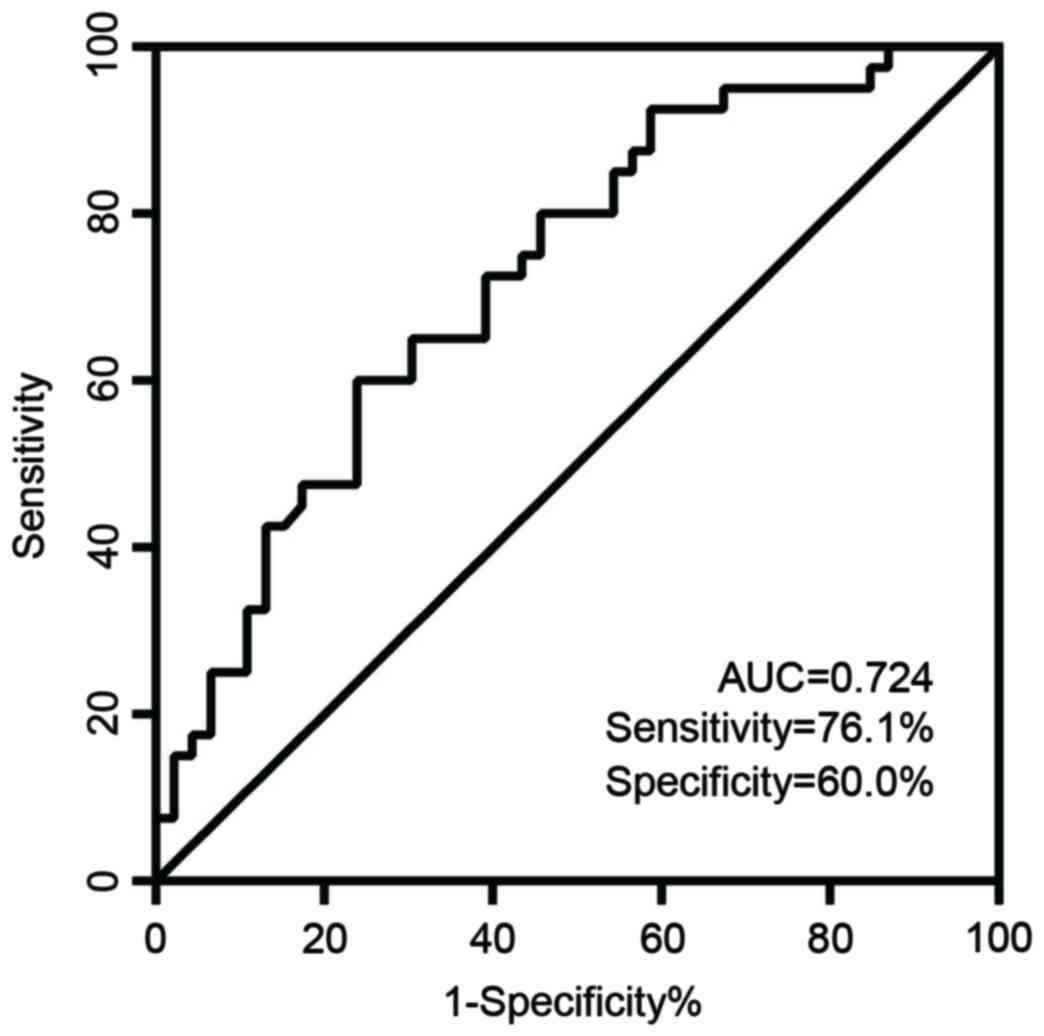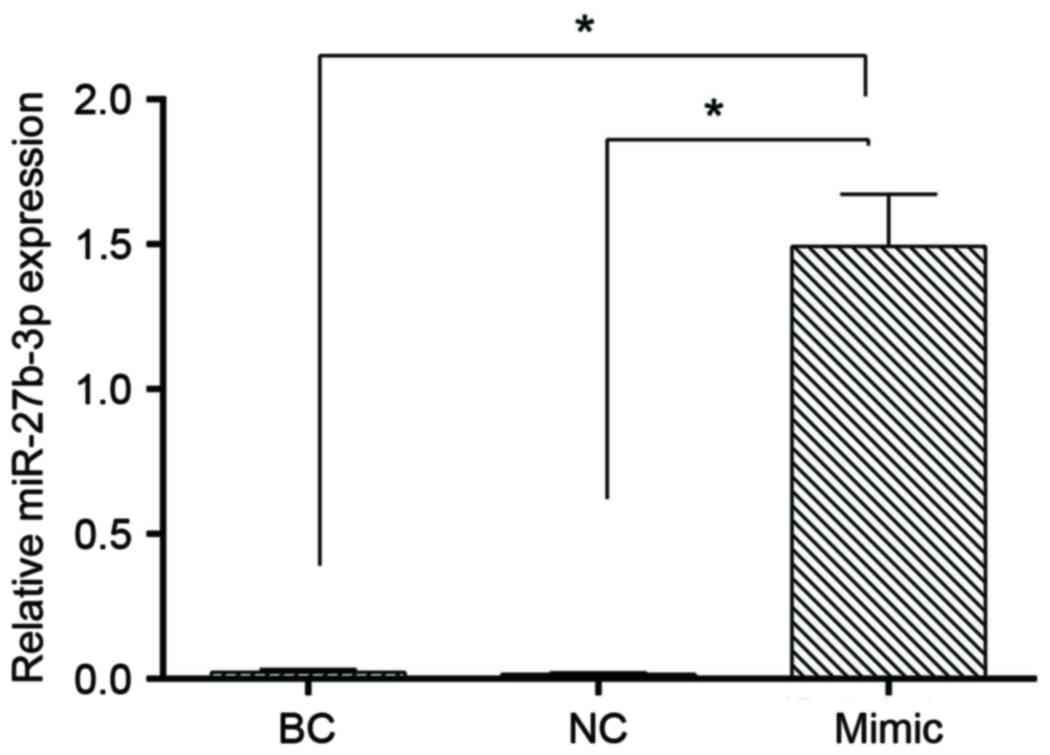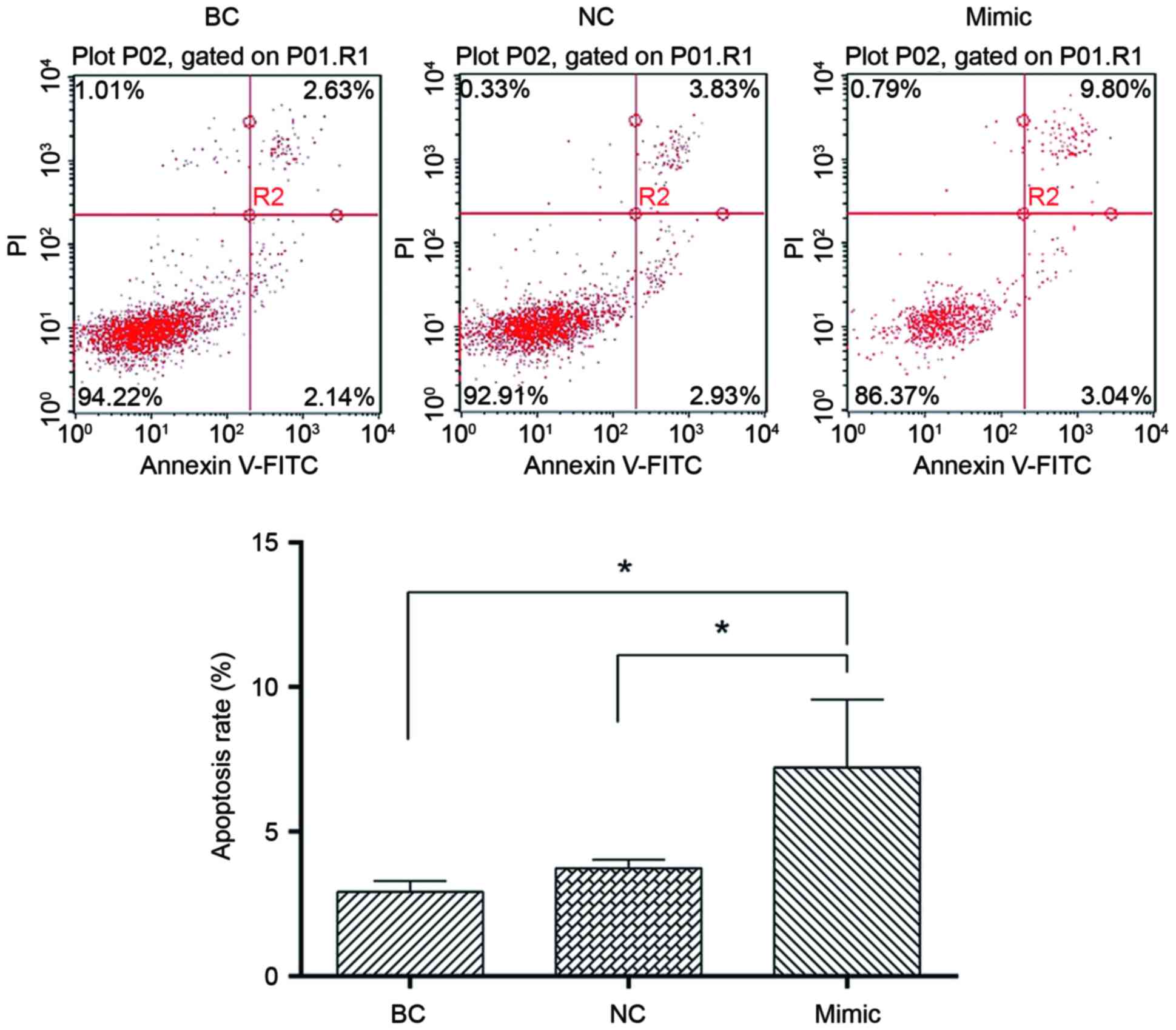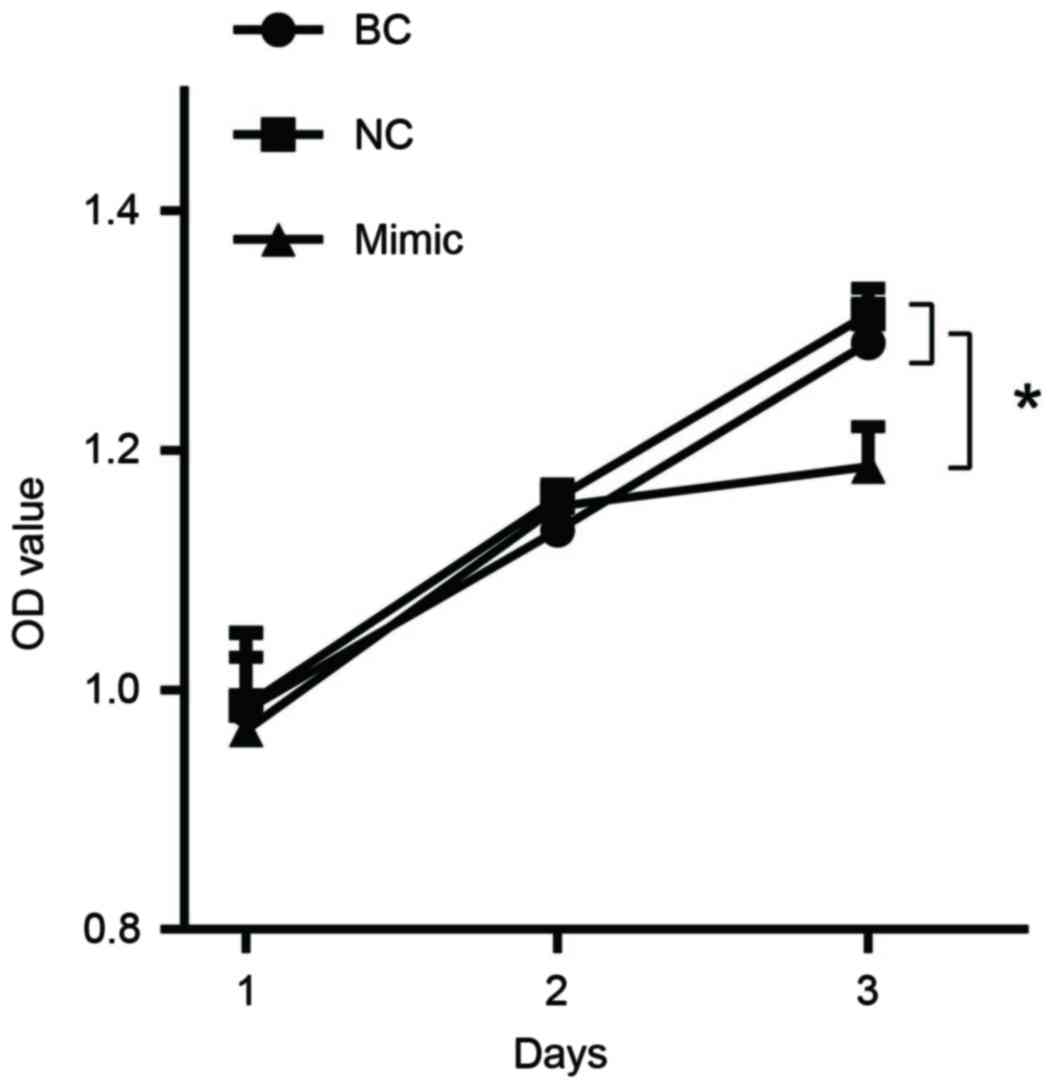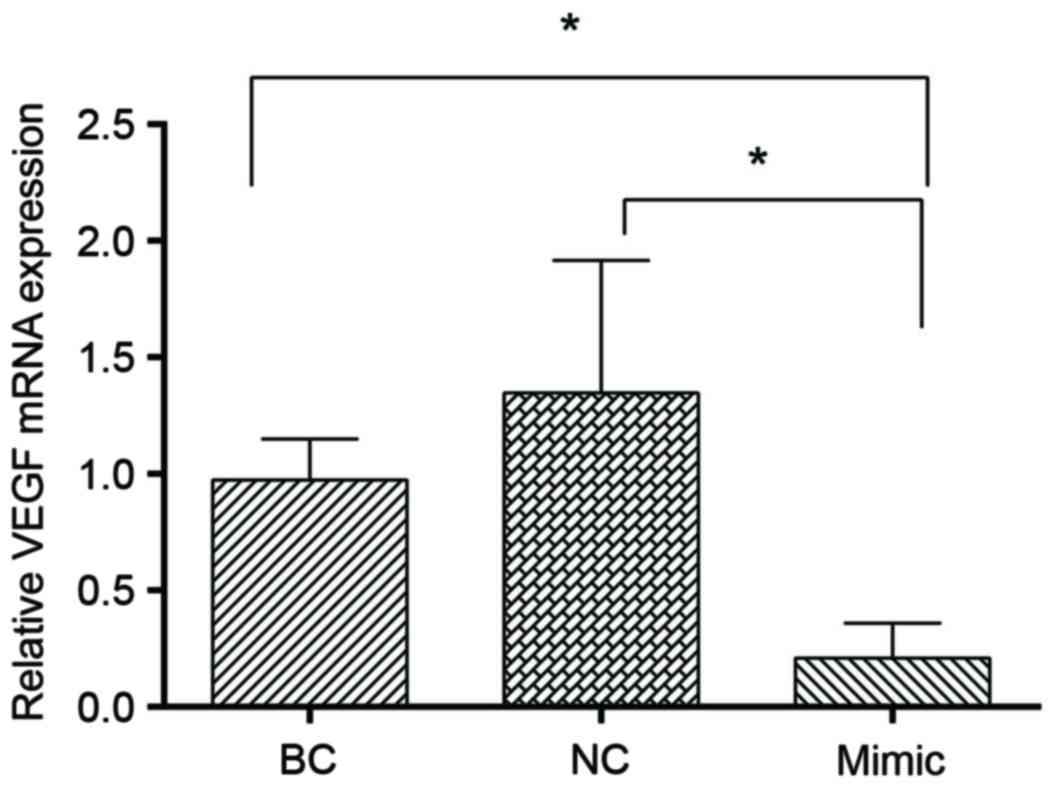Functional role of miR-27b in the development of gastric cancer
- Authors:
- Published online on: February 1, 2018 https://doi.org/10.3892/mmr.2018.8538
- Pages: 5081-5087
-
Copyright: © Chen et al. This is an open access article distributed under the terms of Creative Commons Attribution License.
Abstract
Introduction
Gastric cancer (GC) is the fourth most prevalent type of malignancy and the second leading cause of cancer-associated mortality worldwide; GC exhibits its highest incidence rates in East Asia, Eastern Europe, and South America (1). Over 70% of new cases and mortalities occur in developing countries (1). The 5-year survival rate for patients with GC is <20% due to the frequently late diagnosis; when the tumor is diagnosed and treated at an early stage, the 5-year survival rate may reach 90% (2). The majority of cases of GC are asymptomatic or cause nonspecific symptoms, which may lead to a delayed diagnosis. Approximately 80% of patients are diagnosed at the advanced stages in the majority of countries (3). The conventional treatments for advanced GC, including chemotherapy, radiotherapy and surgery, are associated with poor outcomes (4). Therefore, it is necessary to develop novel noninvasive biomarkers to improve early prognostic prediction, and to develop more effective treatment strategies for GC.
MicroRNAs (miRNAs/miRs) are 19–22-base small non-coding RNA molecules that regulate protein-coding gene expression via the degradation of target mRNAs, or repress translation by binding to the 3′-untranslated regions (3′-UTRs) of the target mRNAs (5). Circulating miRNAs are stable under extreme conditions, including boiling, low or high pH, extended storage and freeze-thaw cycles (6), indicating that they may serve as noninvasive biomarkers for the diagnosis of cancer and other diseases. Accumulating evidence has demonstrated that miRNAs are involved in various cellular processes, including proliferation, apoptosis, development, differentiation and metabolism (7). miRNAs function as oncogenes or tumor suppressors and are aberrantly expressed in various types of malignancy, including pancreatic cancer (8) and GC (9).
Previous studies have demonstrated that miR-23b/27b clustered miRNAs were markedly reduced in numerous types of cancer (10–12). However, the potential role of miR-27b in GC remains unclear. Therefore, the aim of the present study was to determine the functional roles served by miR-27b in the development of GC and to elucidate the molecular mechanisms underlying the pathogenesis of GC.
Materials and methods
Patients and plasma samples
Plasma samples from 46 patients (31 males and 15 females; age, 31–76 years) with GC who had not received surgery, chemotherapy or radiotherapy prior to blood sample collection, and 40 healthy controls (22 males and 18 females; age, 38–70 years), were obtained between January and October 2015 at Guangzhou First People's Hospital of Guangzhou Medical University (Guangzhou, China). The present study was approved by the ethics committee of Guangzhou First People's Hospital of Guangzhou Medical University and informed consent was obtained from each patient.
miRNA microarray analysis
Plasma from 5 random patients with GC and 3 healthy controls was used for miRNA microarray analysis (KangChen Bio-tech, Inc., Shanghai, China). Total RNA was isolated using an miRNeasy mini kit (Qiagen GmbH, Hilden, Germany), according to the manufacturer's protocol. The samples were labeled using the miRCURY™ Hy3™/Hy5™ Power labeling kit and hybridized on the miRCURY™ LNA microRNA Array (version 18.0; Exiqon, Inc., Vedbaek, Denmark). Following salt buffer and detergent (included in the miRCURY™ Hy3™/Hy5™ Power labeling kit; Exiqon, Inc.) washing steps, and in situ hybridization, the slides were scanned using the Axon GenePix 4000B microarray scanner (Molecular Devices LLC, Sunnyvale, CA, USA). Scanned images were then imported into GenePix Pro 6.0 software (Molecular Devices LLC) for grid alignment and data extraction.
Cell culture and transfection
The human GC cell line SGC7901 was purchased from Nanjing KeyGen Biotech Co., Ltd. (Nanjing, China). The cells were cultured in RPMI-1640 medium (Gibco; Thermo Fisher Scientific, Inc., Waltham, MA, USA) containing 10% fetal bovine serum (Gibco; Thermo Fisher Scientific, Inc.) at 37°C in a humidified atmosphere with 5% CO2. SGC7901 cells (5×104 cells/ml) were transfected with the miR-27b mimic (miR-27b-3p mimic sequence 5′-UUCACAGUGGCUAAGUUCUGC-3′) or its negative control (5′-UUUGUACUACACAAAAGUACUG-3′; both Guangzhou RiboBio Co., Ltd., Guangzhou, China) using Lipofectamine 2000 (Invitrogen; Thermo Fisher Scientific, Inc.), according to the manufacturer's protocol, at a final concentration of 50 nM. Following 24 h culture, transfection efficiency was monitored using reverse transcription-quantitative polymerase chain reaction (RT-qPCR) analysis.
RNA isolation and RT-qPCR analysis
Total RNA was extracted from SGC7901 cells using TRIzol reagent (Invitrogen; Thermo Fisher Scientific, Inc.), according to the manufacturer's protocol. Reverse transcription was performed with a reaction mixture of: 5× reaction buffer (2.0 µl), nuclease-free water (5.0 µl), enzyme mix Template (1.0 µl) and total RNA (2.0 µl). The reaction mixture was incubated for 60 min at 42°C, heat-inactivated for 5 min at 95°C prior to immediate cooling at 4°C. The expression level of miR-27b-3p [mature sequence, 5′-UUCACAGUGGCUAAGUUCUGC-3′ (primer sequence unavailable); Takara Biotechnology Co., Ltd., Dalian, China] was assessed using miRCURY LNA™ SYBR® Green master mix (Exiqon, Inc.). miR-16 [mature sequence, 5′-UAGCAGCACGUAAAUAUUGGCG-3′ (primer sequence unavailable); Takara Biotechnology Co., Ltd.] was used for normalization. The qPCR reaction system contained: SYBR-Green master mix (4.8 µl), PCR primer mix (1.0 µl), diluted cDNA templates (4.0 µl), ROX Reference Dye II (0.2 µl). PCR was performed with the following thermocycling conditions: 95°C for 10 min, followed by 40 cycles of 95°C for 10 sec and 60°C for 60 sec.
For quantitative analysis of vascular endothelial growth factor C (VEGFC) mRNA expression, a RT-PCR kit (Takara Biotechnology Co., Ltd.) was used to amplify the target genes, according to the manufacturer's protocol. The expression level of VEGFC was normalized using β-actin mRNA levels. β-actin and VEGFC for RT-qPCR were synthesized by Takara Biotechnology Co., Ltd. The primer sequences were as follows: β-actin, forward (5′-3′) GTAAAGACCTCTATGCCAACA and reverse (5′-3′) GGACTCATCGTACTCCTGCT; VEGFC, forward (5′-3′) AGCACGAGCTACCTCAGCAAGAC and reverse (5′-3′) TTTAGACATGCATCGGCAGGAA. The relative expression levels were calculated using the comparative 2−ΔΔCq method (13).
Cell proliferation assays
SGC7901 cells were seeded in 96-well plates (5×103 cells/well). Following culture at 37°C for 24, 48 and 72 h, respectively, an MTS assay was performed. A total of 20 µl reagent (CellTiter 96 AQueous One Solution Reagent; Promega Corporation, Madison, WI, USA) was added into each well and incubated for 4 h at 37°C in a humidified atmosphere with 5% CO2. The absorbance was recorded at 490 nm using a 96-well plate reader. The proliferation analysis experiments were performed in triplicate.
Cellular apoptosis analysis
SGC7901 cells were seeded in 6-well plates at a density of 105 cells/well. A total of 24 h subsequent to transfection, SGC7901 cells were stained with Annexin V-fluorescein isothiocyanate and propidium iodide (Bestbio, Shanghai, China), according to the manufacturer's protocol. Apoptosis rates were analyzed using Guava EasyCyte Mini System with Cytosoft version 1.2 (EMD Millipore, Billerica, MA, USA). The experiments were repeated three times.
Statistical analysis
All statistical analyses were performed using SPSS 13.0 software (SPSS, Inc., Chicago, IL, USA). The Mann-Whitney U test was used to compare the differences in plasma miR-27b level between the patients with GC and the healthy controls. A receiver operating characteristic (ROC) curve and the area under the ROC curve was used to assess the utility of miR-27b expression levels in distinguishing patients with GC from the healthy controls. All values were presented as the mean ± standard deviation. Statistical analysis was performed using one-way analysis of variance, differences among specific means were assessed by the least significant difference post hoc test. P<0.05 was considered to indicate a statistically significant difference.
Results
miRNAs are expressed differentially between patients with GC and healthy controls
miRNA microarray profiling was performed in 5 GC and 3 healthy control plasma samples. Hierarchical clustering analysis based on the miRNA expression pattern indicated a significant difference between GC plasma and the matched healthy controls. It was observed that 17 miRNAs were significantly upregulated in GC plasma and 64 miRNAs were downregulated compared with the healthy controls (Fig. 1).
Expression of miR-27b is downregulated in GC plasma
To verify the microarray data, RT-qPCR was used to compare the expression of miR-27b between 46 samples of GC plasma and 40 samples of healthy control plasma. miR-16 expression was used as an internal reference to normalize the RT-qPCR data (14). As presented in Fig. 2, it was observed that the expression level of miR-27b was significantly decreased in GC compared with healthy controls. The results of the microarray analysis were consistent with those from RT-qPCR.
Plasma miR-27b correlates with clinicopathological features in GC
The association between circulating miR-27b expression and clinicopathological features of GC is summarized in Table I. The results demonstrated that the level of circulating miR-27b was significantly correlated with differentiation (P=0.029). However, there was no correlation of miR-27b expression with other clinical features, including age, gender, tumor size and invasion (all P>0.05).
Table I.The association between plasma miR-27b-3p expression and clinicopathological characteristics in patients with gastric cancer (n=46). |
Diagnostic value of circulating miR-27b
ROC curve analysis indicated that the plasma level of miR-27b is a potential biomarker for differentiating patients with GC from healthy controls, with a ROC curve area of 0.724 (95% confidence interval=0.618–0.831; P=0.0004) (Fig. 3). When the threshold value for miR-27b was 0.0495, the sensitivity was 76.1% with a specificity of 60%.
Overexpression of miR-27b was examined by RT-qPCR analysis
In order to investigate the role of miR-27b in GC cells, miR-27b was overexpressed using miR-27b mimics, and the expression of miR-27b was determined by RT-qPCR analysis. The results of the present study demonstrated that the expression of miR-27b in the blank control, negative control and miR-27b mimics groups were 0.022±0.104, 0.016±0.005 and 1.493±0.179, respectively. There were ~67.87-fold and ~91.60-fold increases in miR-27b levels in SGC7901 cells transfected with miR-27b mimics compared with the blank control and the negative control, respectively (P<0.05; Fig. 4).
miR-27b overexpression induces GC cellular apoptosis
In order to evaluate the tumor-suppressing potential of miR-27b, SGC7901 cells were transiently transfected with miR-27b mimics or negative control miRNA. Flow cytometric analysis demonstrated that apoptosis in SGC7901 cells transfected with miR-27b mimics was significantly increased compared with cells transfected with the negative control or untreated cells (Fig. 5), suggesting that miR-27b may induce cellular apoptosis. These results indicated that miR-27b may function as a tumor suppressor in human GC development by inducing apoptosis.
miR-27b overexpression suppresses GC cell proliferation
In order to evaluate the effects of miR-27b overexpression on cell proliferation, miR-27b mimics or negative control were transfected into SGC7901 cells. An MTS assay demonstrated that miR-27b mimics induced a significant inhibition of cell proliferation compared with the negative control and blank control on the 3rd day (Fig. 6; P<0.05). Furthermore, a cell growth curve assay additionally demonstrated that miR-27b mimics inhibited cell growth (Fig. 6).
miR-27b inhibits the expression of VEGFC
Previous studies have demonstrated that VEGFC is a target of miR-27b and it can be inhibited by miR-27b (15,16). In order to confirm that miR-27b represses VEGFC expression in SGC7901 cells, RT-qPCR analysis was performed in the present study, and it was observed that transfection with miR-27b mimics led to a significant decrease in VEGFC level (P<0.05; Fig. 7).
Discussion
GC is a lethal malignancy worldwide (17). Due to the nonspecific symptoms of the early stages of GC, diagnosis is frequently delayed. The 5-year survival rate of GC is <20% (12). Therefore, it is necessary to understand the underlying molecular mechanisms and progression stages of the disease, and to investigate novel therapeutic targets.
Numerous studies have demonstrated that the abnormal expression of miRNAs serve a pivotal role in carcinogenesis and cancer progression (10–12,18). Circulating miRNAs are able to withstand harsh conditions (6). Therefore, miRNAs may serve as predictive biomarkers and therapeutic targets for GC.
miR-27b located on chromosome 19p13 which is belongs to the miR-23b/miR-27b cluster (14). miR-27b has been reported to act as a tumor suppressor in certain types of human malignancy, including neuroblastoma (17), clear cell renal cell carcinoma (18), pancreatic cancer (19) and lung cancer (20).
In the present study, it was demonstrated that miR-27b expression was significantly downregulated in the plasma of patients with GC, and it was demonstrated that decreased expression of miR-27b was associated with poor differentiation. Overexpression of miR-27b inhibited cancer cell proliferation and induced apoptosis in SGC7901 cells. VEGFC belongs to the platelet-derived growth factor family, and is a potent inducer of lymphangiogenesis by activating the vascular endothelial growth factor receptor 3 signaling pathway (21). The present study confirmed that VEGFC may be inhibited by miR-27b. The results of the present study demonstrated that miR-27b may be a candidate tumor suppressor by inhibiting VEGFC in GC. Previous studies have demonstrated that VEGFC is a target of miR-27b (15,16). miR-27b was observed to be downregulated in colorectal cancer, and overexpression of miR-27b repressed colorectal cancer cell proliferation, colony formation and tumor growth by targeting VEGFC (17). Downregulation of VEGFC in lung and colon cancer cells led to a significant inhibition of tumor growth and metastasis (18). VEGFC is therefore an attractive target for the development of novel anticancer strategies.
Overexpression of VEGFA and VEGFC in GC has been demonstrated to correlate with prognosis, and their silencing may effectively inhibit cancer growth (22). VEGFC was highly expressed in the gastric tumor tissues obtained in the present study. Additionally, the expression of VEGFC was correlated with the pathological staging of GC. The growth of gastric tumor cells was significantly inhibited by transfecting with an antisense VEGFC gene (23). Various studies have demonstrated VEGFC can induce lymphangiogenesis (24–26). Overexpression of VEGFC has been observed to increase leukemic cell proliferation in a dose-dependent manner by inducing the expression of apoptosis regulator Bcl-2 and increasing the Bcl-2/apoptosis regulator Bax ratio (27).
In the present study, it was observed that miR-27b significantly decreased VEGFC mRNA expression, inhibited cancer cell proliferation and induced apoptosis in SGC7901 cells. Therefore, it is possible that VEGFC is associated with lymphangiogenesis in addition to cell proliferation and apoptosis.
In conclusion, the results of the present study demonstrated that plasma miR-27b was downregulated in GC. The plasma level of miR-27b is a potential biomarker for the differentiation between patients with GC and healthy individuals. Upregulation of miR-27b suppressed cell proliferation and induced apoptosis in GC cell lines. Blocking the VEGFC signaling pathway may prove to be an effective treatment for GC by targeting GC cells in addition to the neovasculature. The results of the present study suggested that miR-27b may be a potential biomarker and molecular therapeutic target for GC.
Acknowledgements
The present study was supported by the Guangzhou Key Project of Medical and Health Science and Technology (grant no. 201102A212011).
Competing interests
The authors declare they have no competing interests.
References
|
Jemal A, Bray F, Center MM, Ferlay J, Ward E and Forman D: Global cancer statistics. CA Cancer J Clin. 61:69–90. 2011. View Article : Google Scholar : PubMed/NCBI | |
|
Miyahara R, Niwa Y, Matsuura T, Maeda O, Ando T, Ohmiya N, Itoh A, Hirooka Y and Goto H: Prevalence and prognosis of gastric cancer detected by screening in a large Japanese population: Data from a single institute over 30 years. J Gastroenterol Hepatol. 22:1435–1442. 2007. View Article : Google Scholar : PubMed/NCBI | |
|
Correa P: Gastric cancer: Overview. Gastroenterol Clin North Am. 42:211–217. 2013. View Article : Google Scholar : PubMed/NCBI | |
|
Takahashi T, Saikawa Y and Kitagawa Y: Gastric cancer: Current status of diagnosis and treatment. Cancers (Basel). 5:48–63. 2013. View Article : Google Scholar : PubMed/NCBI | |
|
Bartel DP: MicroRNAs: Genomics, biogenesis, mechanism, and function. Cell. 116:281–297. 2004. View Article : Google Scholar : PubMed/NCBI | |
|
Chen X, Ba Y, Ma L, Cai X, Yin Y, Wang K, Guo J, Zhang Y, Chen J, Guo X, et al: Characterization of microRNAs in serum: A novel class of biomarkers for diagnosis of cancer and other diseases. Cell Res. 18:997–1006. 2008. View Article : Google Scholar : PubMed/NCBI | |
|
Ambros V: The functions of animal microRNAs. Nature. 431:350–355. 2004. View Article : Google Scholar : PubMed/NCBI | |
|
Hamada S, Satoh K, Fujibuchi W, Hirota M, Kanno A, Unno J, Masamune A, Kikuta K, Kume K and Shimosegawa T: miR-126 acts as a tumor suppressor in pancreatic cancer cells via the regulation of ADAM9. Mol Cancer Res. 10:3–10. 2012. View Article : Google Scholar : PubMed/NCBI | |
|
Hashiguchi Y, Nishida N, Mimori K, Sudo T, Tanaka F, Shibata K, Ishii H, Mochizuki H, Hase K, Doki Y and Mori M: Down-regulation of miR-125a-3p in human gastric cancer and its clinicopathological significance. Int J Oncol. 40:1477–1482. 2012.PubMed/NCBI | |
|
Chen L, Li H, Han L, Zhang K, Wang G, Wang Y, Liu Y, Zheng Y, Jiang T, Pu P, et al: Expression and function of miR-27b in human glioma. Oncol Rep. 26:1617–1621. 2011.PubMed/NCBI | |
|
Lee JJ, Drakaki A, Iliopoulos D and Struhl K: miR-27b targets PPARγ to inhibit growth, tumor progression and the inflammatory response in neuroblastoma cells. Oncogene. 31:3818–3825. 2012. View Article : Google Scholar : PubMed/NCBI | |
|
Ishihara T, Seki N, Inoguchi S, Yoshino H, Tatarano S, Yamada Y, Itesako T, Goto Y, Nishikawa R, Nakagawa M and Enokida H: Expression of the tumor suppressive miRNA-23b/27b cluster is a good prognostic marker in clear cell renal cell carcinoma. J Urol. 192:1822–1830. 2014. View Article : Google Scholar : PubMed/NCBI | |
|
Schmittgen TD and Livak KJ: Analyzing real-time PCR data by the comparative C(T) method. Nat Protoc. 3:1101–1108. 2008. View Article : Google Scholar : PubMed/NCBI | |
|
Song J, Bai Z, Han W, Zhang J, Meng H, Bi J, Ma X, Han S and Zhang Z: Identification of suitable reference genes for qPCR analysis of serum microRNA in gastric cancer patients. Dig Dis Sci. 57:897–904. 2012. View Article : Google Scholar : PubMed/NCBI | |
|
Ye J, Wu X, Wu D, Wu P, Ni C, Zhang Z, Chen Z, Qiu F, Xu J and Huang J: miRNA-27b targets vascular endothelial growth factor C to inhibit tumor progression and angiogenesis in colorectal cancer. PLoS One. 8:e606872013. View Article : Google Scholar : PubMed/NCBI | |
|
Khromova N, Kopnin P, Rybko V and Kopnin BP: Downregulation of VEGF-C expression in lung and colon cancer cells decelerates tumor growth and inhibits metastasis via multiple mechanisms. Oncogene. 31:1389–1397. 2012. View Article : Google Scholar : PubMed/NCBI | |
|
Kamangar F, Dores GM and Anderson WF: Patterns of cancer incidence, mortality, and prevalence across five continents: Defining priorities to reduce cancer disparities in different geographic regions of the world. J Clin Oncol. 24:2137–2150. 2006. View Article : Google Scholar : PubMed/NCBI | |
|
Lu J, Getz G, Miska EA, Alvarez-Saavedra E, Lamb J, Peck D, Sweet-Cordero A, Ebert BL, Mak RH, Ferrando AA, et al: MicroRNA expression profiles classify human cancers. Nature. 435:834–838. 2005. View Article : Google Scholar : PubMed/NCBI | |
|
Bera A, VenkataSubbaRao K, Manoharan MS, Hill P and Freeman JW: A miRNA signature of chemoresistant mesenchymal phenotype identifies novel molecular targets associated with advanced pancreatic cancer. PLoS One. 9:e1063432014. View Article : Google Scholar : PubMed/NCBI | |
|
Yanaihara N, Caplen N, Bowman E, Seike M, Kumamoto K, Yi M, Stephens RM, Okamoto A, Yokota J, Tanaka T, et al: Unique microRNA molecular profiles in lung cancer diagnosis and prognosis. Cancer Cell. 9:189–198. 2006. View Article : Google Scholar : PubMed/NCBI | |
|
Olofsson B, Jeltsch M, Eriksson U and Alitalo K: Current biology of VEGF-B and VEGF-C. Curr Opin Biotechnol. 10:528–538. 1999. View Article : Google Scholar : PubMed/NCBI | |
|
Wang X, Chen X, Fang J and Yang C: Overexpression of both VEGF-A and VEGF-C in gastric cancer correlates with prognosis, and silencing of both is effective to inhibit cancer growth. Int J Clin Exp Pathol. 6:586–597. 2013.PubMed/NCBI | |
|
Zhu P, Zhang J, Chen Q, Wang J and Wang Y: Expression of vascular endothelial growth factor-C in gastric carcinoma and the effect of its antisense gene transfection on the proliferation of human gastric cancer cell line SGC-7901. Am J Surg. 204:78–83. 2012. View Article : Google Scholar : PubMed/NCBI | |
|
Skobe M, Hawighorst T, Jackson DG, Prevo R, Janes L, Velasco P, Riccardi L, Alitalo K, Claffey K and Detmar M: Induction of tumor lymphangiogenesis by VEGF-C promotes breast cancer metastasis. Nat Med. 7:192–198. 2001. View Article : Google Scholar : PubMed/NCBI | |
|
Steven AS, Achen MG, Jussila L, Baldwin ME and Alitalo K: Lymphangiogenesis and cancer metastasis. Nat Rev Cancer. 2:573–583. 2002. View Article : Google Scholar : PubMed/NCBI | |
|
Tammela T and Alitalo K: Lymphangiogenesis: Molecular mechanisms and future promise. Cell. 140:460–476. 2010. View Article : Google Scholar : PubMed/NCBI | |
|
Dias S, Choy M, Alitalo K and Rafii S: Vascular endothelial growth factor (VEGF)-C signaling through FLT-4 (VEGFR-3) mediates leukemic cell proliferation, survival, and resistance to chemotherapy. Blood. 99:2179–2184. 2002. View Article : Google Scholar : PubMed/NCBI |



